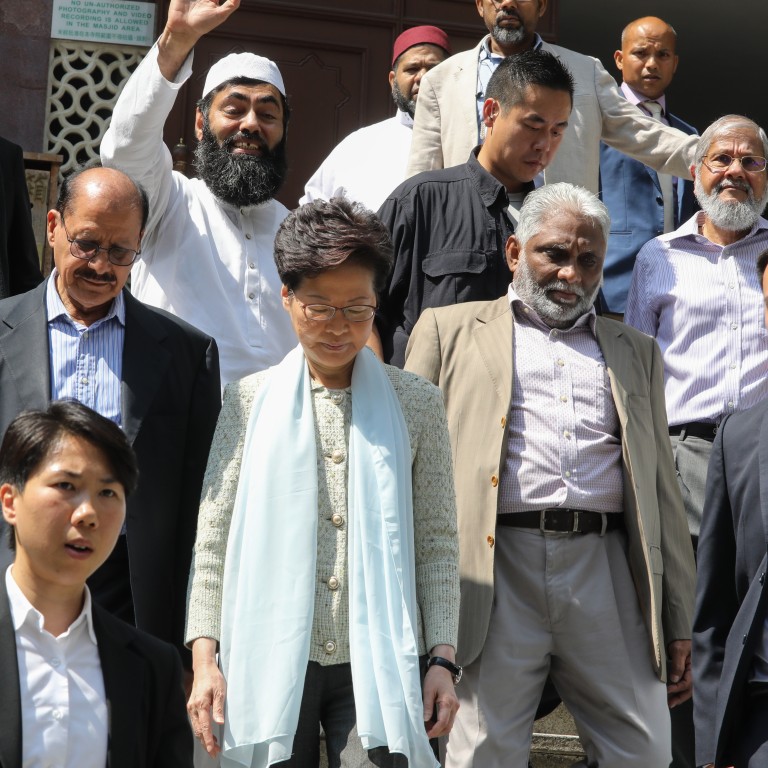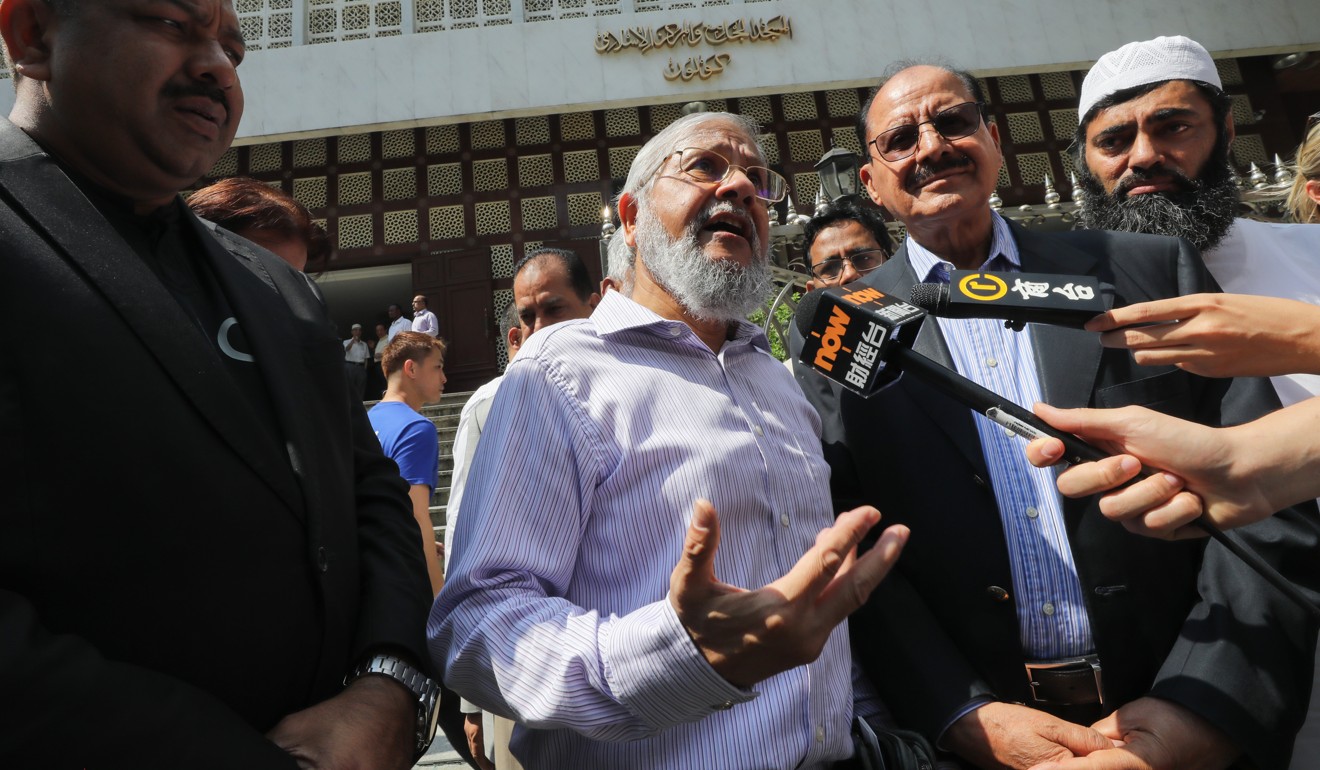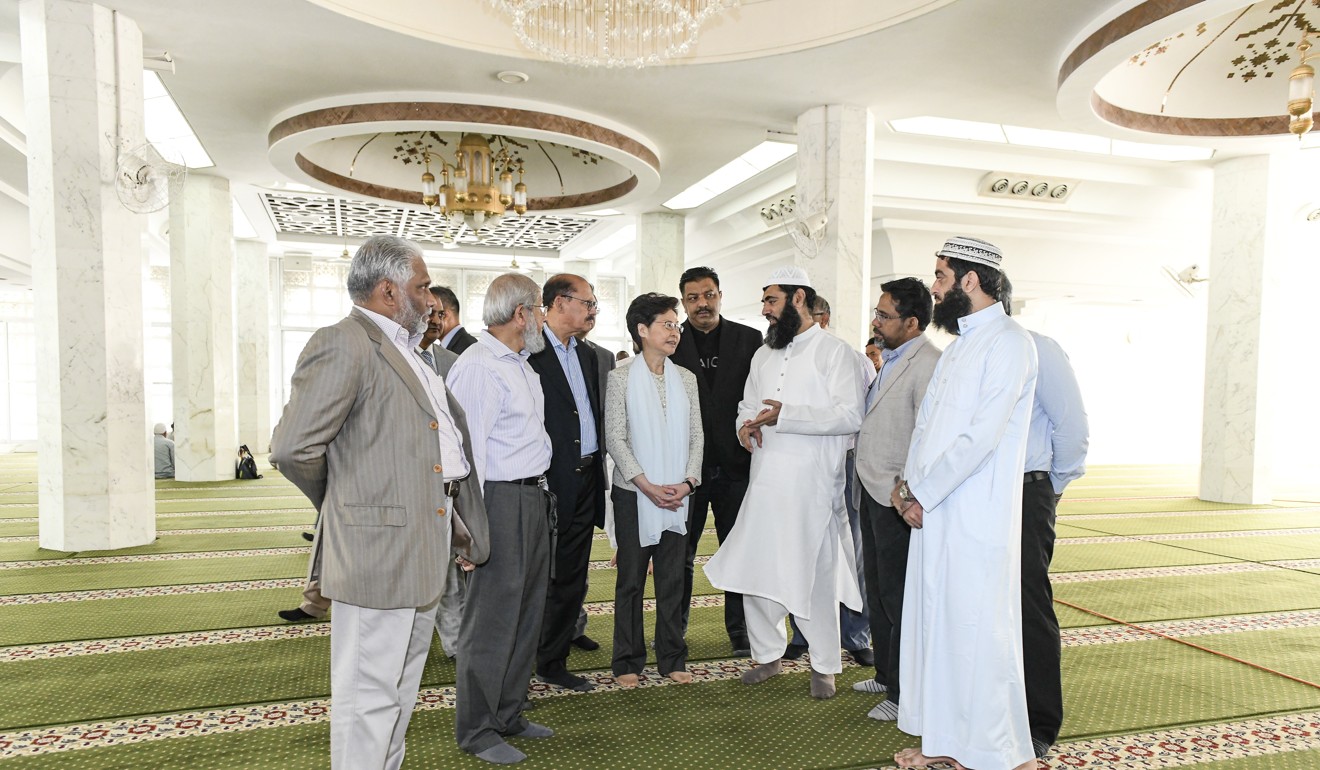
Hong Kong protests: city leader Carrie Lam and police chief Stephen Lo apologise after water cannon sprays mosque entrance
- During clashes with protesters on Sunday, vehicle stopped and sprayed blue dye at the Tsim Sha Tsui venue
- Leader and police chief meet community representatives, who accept apology, urging calm among local Muslims
Hong Kong’s beleaguered leader and police chief apologised on Monday to the local Islamic community after the entrance of the city’s biggest mosque was sprayed with blue solution from a water cannon attempting to disperse anti-government protesters.
They said the soaking at Kowloon Mosque was an accident, with police later saying an aim of the operation had been to protect the site on Nathan Road.
Chief Executive Carrie Lam Cheng Yuet-ngor and Commissioner of Police Stephen Lo Wai-chung visited the mosque a day after disturbances erupted in Tsim Sha Tsui and neighbouring areas.
Protesters blocked roads and trashed and burned MTR stations and shops with mainland Chinese links on Sunday, as unrest sparked by opposition to a since-withdrawn extradition bill finished its 20th straight weekend.
Lam and Lo met members of the Islamic Trust, a local community group, at the mosque. The city’s leader was heckled by chanting onlookers when she left after the 25-minute meeting.
Said Uddin, secretary of the trust, said: “The chief executive and police commissioner said, ‘A mistake has been made and we are sorry for that.’
“And we accept [that], because what’s done is done … and they will not repeat it.”
The trust’s chairman, Zoheir Tyebkhan, said: “They sincerely apologised and said it was not intentional.”
He added the group would urge calm among the local Islamic community.
“This is our home, everybody’s home, we want it to be what it was,” he said.

“The Muslim community in Hong Kong ... [is] very peaceful and we do not involve ourselves in anything. There is no reason for [police] to storm the mosque.”
Others were more critical of the force for coating the sacred site with dye, intended to make it easier to identify frontline protesters.
Mohan Chugani, the former president of the Indian Association of Hong Kong, said the water cannon took aim at bystanders, himself included, despite there being no protesters in sight.
He said Lam called him earlier to offer a personal apology and to explain that police had to handle a “heightened” situation.
Does Hong Kong have a silent majority yearning to condemn protests?
While Chugani accepted the apology in principle, he said he planned to make a formal complaint to police.
“I told [Lam] that police should not do that to innocent bystanders,” he said.

Call for special Hong Kong court to fast-track protesters’ cases
At a news conference on Monday, Swalikh Mohammed, superintendent at the Cyber Security and Technology Crime Bureau, said the incident happened during a “dispersal operation”.
“One of the missions was to protect the mosque,” he said.
“We did not aim to spray water at the mosque but some accidentally splashed the front gate.”
“We have offered our sincere apology,” said Mohammed, adding that he himself is a Muslim.
“Last Friday, I met many Muslims concerned the mosque would be targeted. An aim of our operation was to avoid people stirring up trouble outside the mosque.”
Man remanded in custody accused of stabbing Hong Kong protester
In response to criticism the force’s response was too slow, Mohammed said they were in touch with the community and tried to recruit volunteers to help clean up the mosque soon after the incident.
The force also apologised to bystanders who were caught up in the incident.

Phyllis Cheung Fung-mei, of Hong Kong Unison, said she felt “burning pain” after being sprayed outside the mosque, which she and no more than 15 others were trying to protect from escalating violence nearby.
She said none of them were wearing protective gear or face masks.
“We did not provoke nor interfere with the police operation. I don’t understand why [police] thought we were protesters,” she said.
Top Hong Kong school accused of curbing freedoms with political events ban
Lawmaker Jeremy Tam Man-ho also went to Kowloon Mosque to safeguard the mosque during protests. He said he was seeking legal advice over the “indiscriminate attack”.
Alex McCoy, the vicar of St Andrew’s Church, which sits close to Kowloon Mosque, said a small part of the church’s gate was also sprayed by the police’s blue dye.
Party mouthpiece slams university chief over police abuse inquiry call
Police apologised on Monday, stressing the force did not intentionally target the church. McCoy accepted the apology.
“We understand that the use of the cannon … can be rather indiscriminate,” he said.
McCoy urged Hongkongers to listen to each other with empathy.
Additional reporting by Phila Siu, Ng Kang-chung and Karen Zhang


